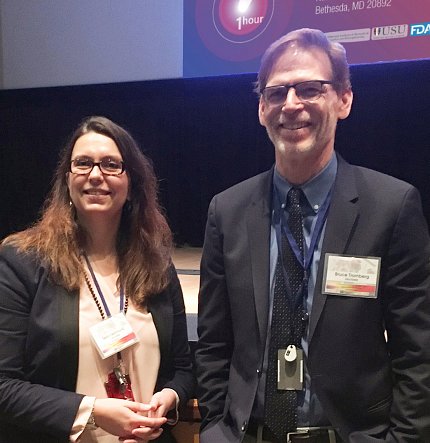Innovations in Technology to Extend the ‘Golden Hour’

Photo: Raymond Macdougall
The “golden hour” is a concept in trauma care medicine that describes the critical first hour after a life-threatening injury, when medical and surgical interventions may determine a patient’s survival. At a recent workshop, civilian and military clinicians and bioengineers met at NIH to consider a roadmap for “Innovations in Technologies to Extend the Golden Hour.”
“Trauma is the leading cause of death in people under the age of 40 years in developed countries,” said co-organizer Dr. Seila Selimovic, director of NIBIB programs in biosensors and tissue engineering, noting that proximity to medical facilities can make a big difference in outcomes. “An injured person in an urban environment may be able to reach an emergency room within 20-30 minutes, while a person living in a rural environment may not reach a hospital for a full hour after the injury.” The time that elapses prior to reaching a hospital becomes longer in natural disasters and for soldiers on the battlefield, she said.
The workshop is among the first to engage civilian and military experts in promoting innovation of technologies to extend the golden hour. Bioengineered solutions hold promise for improved diagnostic treatment of acute injuries and shock, to increase survival and recovery rates. New technologies have been introduced in recent years, many pioneered in battle in Afghanistan and Iraq. Others face technical, financial or logistical obstacles before their potential to save lives is realized.
“The future of medicine is about continuous dynamic biology, and it requires continuous sensing, feedback and control systems—technologies that we love to apply in engineering,” said NIBIB director Dr. Bruce Tromberg. “This is essential for advancing the future of medicine in general, and I think it is going to be leveraged beautifully into advancing what we can do in that golden hour.”
Some examples of biomedical technologies already used in critical care include tourniquets; hemostatic agents, which are applied to trauma pads and combat gauze to stanch hemorrhages; organ support technologies such as tracheostomy tubes, ventilators and dialysis systems; non-invasive imaging for burn patient care; and wearable sensors to monitor heart and breathing rates and to prompt caregivers.
Dr. Thomas Scalea, physician-in-chief at the University of Maryland Shock Trauma Center, said the golden hour doesn’t always equal a 60-minute window; rather there are many time-sensitive aspects to treating a living patient in real time. These include airway control, blood loss, brain injury, fractures and weak blood circulation. “Extending the golden hour doesn’t mean doing the same things faster,” he said. “This involves taking the therapy out of the emergency department and into the field.”
Battlefield medicine should not be overlooked in importance for a modernized military, according to Col. Michael Davis, a physician who directs the U.S. Army Medical Research and Materiel Command’s Combat Casualty Care Research Program. “Military medicine faces a crisis of relevance,” he said. “We have to educate and inform [leadership] about how important medical care is to winning on the battlefield.”
After an overview of civilian and military needs, breakout groups focused on organ support technologies; radiation exposure/burn and wound-healing; hemostatic medical devices; portable imaging technologies; and wearable biosensors. The workshop will be summarized for the potential of further collaboration and priorities for trauma care research.
